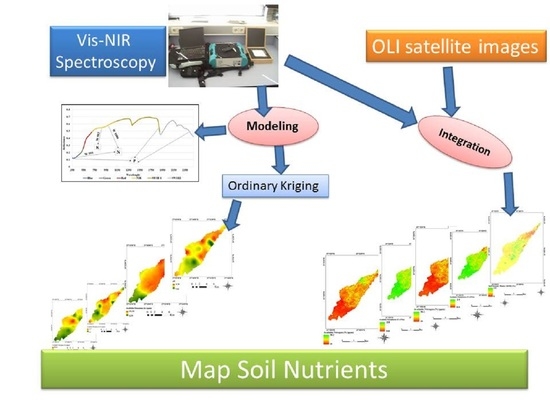Vis-NIR Spectroscopy and Satellite Landsat-8 OLI Data to Map Soil Nutrients in Arid Conditions: A Case Study of the Northwest Coast of Egypt
Abstract
1. Introduction
2. Materials and Methods
2.1. Experimental Site
2.2. Soil Sampling and Chemical Analysis
2.3. Digital Image Processing
2.4. Spectral Measurements of the Soil Samples
2.5. Model Calibration and Validation
2.6. Mapping Soil Properties Using Ordinary Kriging
2.7. Mapping N, P, K, SOM, and pH Using the Landsat 8 OLI
2.8. Soil Fertility Status of Wadi El-Garawla
3. Results
3.1. Soil Characteristics
3.2. Spectral Characteristics of Studied Soil
3.3. Prediction of N, P, K, pH, and SOM
3.4. Mapping of Soil Nutrients of Based on Ordinary Kriging
3.5. Mapping of Soil Nutrients Using Landsat-8 OLI Images
3.6. Soil Fertility Status of Wadi El-Garawla
4. Discussion
5. Conclusions
Author Contributions
Funding
Acknowledgments
Conflicts of Interest
References
- Mohamed, E.S.; Abu-Hashim, M.; Belal, A.A.A. Sustainable indicators in arid region: Case study–Egypt. In Sustainability of Agricultural Environment in Egypt; Springer Cham: Basel, Switzerland, 2018; Part I; pp. 273–293. [Google Scholar]
- AbdelRahman, M.A.; Shalaby, A.; Mohamed, E.S. Comparison of two soil quality indices using two methods based on geographic information system. Egypt. J. Remote Sens. Space Sci. 2019, 22, 127–136. [Google Scholar] [CrossRef]
- Abu-hashim, M.; Elsayed, M.; Belal, A.E. Effect of land-use changes and site variables on surface soil organic carbon pool at Mediterranean Region. J. Afr. Earth Sci. 2016, 114, 78–84. [Google Scholar] [CrossRef]
- Hendawy, E.; Belal, A.A.; Mohamed, E.S.; Elfadaly, A.; Murgante, B.; Aldosari, A.A.; Lasaponara, R. The prediction and assessment of the impacts of soil sealing on agricultural land in the North Nile Delta (Egypt) using satellite data and GIS modeling. Sustainability 2019, 11, 4662. [Google Scholar] [CrossRef]
- Mohamed, E.S.; Morgun, E.G.; Bothina, S.G. Assessment of soil salinity in the Eastern Nile Delta (Egypt) using geoinformation techniques. Mosc. Univ. Soil Sci. Bull. 2011, 66, 11–14. [Google Scholar] [CrossRef]
- Hammam, A.A.; Mohamed, E.S. Mapping soil salinity in the East Nile Delta using several methodological approaches of salinity assessment. Egypt. J. Remote Sens. Space Sci. 2018. [Google Scholar] [CrossRef]
- Hassan, A.M.; Belal, A.A.; Hassan, M.A.; Farag, F.M.; Mohamed, E.S. Potential of thermal remote sensing techniques in monitoring waterlogged area based on surface soil moisture retrieval. J. Afr. Earth Sci. 2019, 155, 64–74. [Google Scholar] [CrossRef]
- Saleh, A.M.; Belal, A.B.; Mohamed, E.S. Land resources assessment of El-Galaba basin, South Egypt for the potentiality of agriculture expansion using remote sensing and GIS techniques. Egypt. J. Remote Sens. Space Sci. 2015, 18, S19–S30. [Google Scholar] [CrossRef]
- Horta, A.; Malone, B.; Stockmann, U.; Minasny, B.; Bishop, T.F.A.; McBratney, A.B.; Pallasser, R.; Pozza, L. Potential of integrated field spectroscopy and spatial analysis for enhanced assessment of soil contamination: A prospective review. Geoderma 2015, 241, 180–209. [Google Scholar] [CrossRef]
- Angelopoulou, T.; Tziolas, N.; Balafoutis, A.; Zalidis, G.; Bochtis, D. Remote sensing techniques for soil organic carbon estimation: A review. Remote Sens. 2019, 11, 676. [Google Scholar] [CrossRef]
- Chen, F.; Kissel, D.E.; West, L.T.; Adkins, W. Field-scale mapping of surface soil organic carbon using remotely sensed imagery. Soil Sci. Soc. Am. J. 2000, 64, 746–753. [Google Scholar] [CrossRef]
- Rossel, R.V.; Adamchuk, V.I.; Sudduth, K.A.; McKenzie, N.J.; Lobsey, C. Proximal soil sensing: An effective approach for soil measurements in space and time. In Advances in Agronomy; Academic Press: Cambridge, MA, USA, 2011; Volume 113, pp. 243–291. [Google Scholar]
- Nawar, S.; Buddenbaum, H.; Hill, J.; Kozak, J. Modeling and mapping of soil salinity with reflectance spectroscopy and landsat data using two quantitative methods (PLSR and MARS). Remote Sens. 2014, 6, 10813–10834. [Google Scholar] [CrossRef]
- Abd-Elmabod, S.K.; Alice, F.; Zhang, Z.; Ali, R.R.; Jones, L. Rapid urbanisation threatens fertile agricultural land and soil carbon in the Nile delta. J. Environ. Manag. 2019, 252, 109668. [Google Scholar] [CrossRef] [PubMed]
- Effat, H.A.; El-Zeiny, A.M. Integration of satellite data and spatial decision models for zoning new urban communities in El-Fayoum Desert. Arab. J. Geosci. 2020, 13, 1–13. [Google Scholar] [CrossRef]
- Ben-Dor, E.; Banin, A. Near-infrared analysis as a rapid method to simultaneously evaluate several soil properties. Soil Sci. Soc. Am. J. 1995, 59, 364–372. [Google Scholar] [CrossRef]
- Nawar, S.; Buddenbaum, H.; Hill, J. Digital mapping of soil properties using multivariate statistical analysis and ASTER data in an arid region. Remote Sens. 2015, 7, 1181–1205. [Google Scholar] [CrossRef]
- Nawar, S.; Mouazen, A.M. On-line Vis-NIR spectroscopy prediction of soil organic carbon using machine learning. Soil Tillage Res. 2019, 190, 120–127. [Google Scholar] [CrossRef]
- Mohamed, E.S.; Saleh, A.M.; Belal, A.B.; Gad, A. Application of near-infrared reflectance for quantitative assessment of soil properties. Egypt. J. Remote Sens. Space Sci. 2018, 21, 1–14. [Google Scholar] [CrossRef]
- Khayamim, F.; Wetterlind, J.; Khademi, H.; Robertson, A.J.; Cano, A.F.; Stenberg, B. Using visible and near infrared spectroscopy to estimate carbonates and gypsum in soils in arid and subhumid regions of Isfahan, Iran. J. Near Infrared Spectrosc. 2015, 23, 155–165. [Google Scholar] [CrossRef]
- Abdul Munnaf, M.; Nawar, S.; Mouazen, A.M. Estimation of Secondary Soil Properties by Fusion of Laboratory and On-Line Measured Vis–NIR Spectra. Remote Sens. 2019, 11, 2819. [Google Scholar] [CrossRef]
- Fang, Q.; Hong, H.; Zhao, L.; Kukolich, S.; Yin, K.; Wang, C. Visible and near-infrared reflectance spectroscopy for investigating soil mineralogy: A review. J. Spectrosc. 2018, 2018, 1–14. [Google Scholar] [CrossRef]
- Paz-Kagan, T.; Zaady, E.; Salbach, C.; Schmidt, A.; Lausch, A.; Zacharias, S.; Notesco, G.; Ben-Dor, E.; Karnieli, A. Mapping the spectral soil quality index (SSQI) using airborne imaging spectroscopy. Remote Sens. 2015, 7, 15748–15781. [Google Scholar] [CrossRef]
- El Nahry, A.H.; Mohamed, E.S. Potentiality of land and water resources in African Sahara: A case study of south Egypt. Environ. Earth Sci. 2011, 63, 1263–1275. [Google Scholar] [CrossRef]
- Bayer, A.; Bachmann, M.; Müller, A.; Kaufmann, H. A comparison of feature-based MLR and PLS regression techniques for the prediction of three soil constituents in a degraded South African ecosystem. Appl. Environ. Soil Sci. 2012, 2012, 1–20. [Google Scholar] [CrossRef]
- Islam, K.; Singh, B.; McBratney, A. Simultaneous estimation of several soil properties by ultra-violet, visible, and near-infrared reflectance spectroscopy. Soil Res. 2003, 41, 1101–1114. [Google Scholar] [CrossRef]
- Rossel, R.V.; Walvoort, D.J.J.; McBratney, A.B.; Janik, L.J.; Skjemstad, J.O. Visible, near infrared, mid infrared or combined diffuse reflectance spectroscopy for simultaneous assessment of various soil properties. Geoderma 2006, 131, 59–75. [Google Scholar] [CrossRef]
- Qiao, Y.; Zhang, S. Near-infrared spectroscopy technology for soil nutrients detection based on LS-SVM. In International Conference on Computer and Computing Technologies in Agriculture; Springer: Berlin/Heidelberg, Germany, 2011; pp. 325–335. [Google Scholar]
- Rossel, R.V.; McBratney, A.B. Laboratory evaluation of a proximal sensing technique for simultaneous measurement of soil clay and water content. Geoderma 1998, 85, 19–39. [Google Scholar] [CrossRef]
- Abd-Elmabod, S.K.; Muñoz-Rojas, M.; Jordán, A.; Anaya-Romero, M.; Phillips, J.D.; Jones, L.; Zhang, Z.; Pereira, P.; Fleskens, L.; Van Der Ploeg, M.; et al. Climate change impacts on agricultural suitability and yield reduction in a Mediterranean region. Geoderma 2020, 374, 114453. [Google Scholar] [CrossRef]
- El Baroudy, A.A. Mapping and evaluating land suitability using a GIS-based model. Catena 2016, 140, 96–104. [Google Scholar] [CrossRef]
- Barbosa, A.; Marinho, T.; Martin, N.; Hovakimyan, N. Multi-Stream CNN for spatial resource allocation: A crop management application. In Proceedings of the IEEE/CVF Conference on Computer Vision and Pattern Recognition Workshops, Seattle, WA, USA, 16–18 June 2020; pp. 58–59. [Google Scholar]
- Preston, W.; Araújo do Nascimento, C.W.; Agra Bezerra da Silva, Y.J.; Silva, D.J.; Alves Ferreira, H. Soil fertility changes in vineyards of a semiarid region in Brazil. J. Soil Sci. Plant Nutr. 2017, 17, 672–685. [Google Scholar] [CrossRef]
- Shrivastava, P.; Kumar, R. Soil salinity: A serious environmental issue and plant growth promoting bacteria as one of the tools for its alleviation. Saudi J. Biol. Sci. 2015, 22, 123–131. [Google Scholar] [CrossRef]
- Schütz, L.; Gattinger, A.; Meier, M.; Müller, A.; Boller, T.; Mäder, P.; Mathimaran, N. Improving crop yield and nutrient use efficiency via biofertilization—A global meta-analysis. Front. Plant Sci. 2018, 8, 2204. [Google Scholar] [CrossRef] [PubMed]
- Khdery, G.; Gad, A.A.; El-Zeiny, A.M. Spectroscopic Characterization of Plant Cover in El-Fayoum Governorate, Egypt. Egypt. J. Soil Sci. 2020. [Google Scholar] [CrossRef]
- Bellon-Maurel, V.; Fernandez-Ahumada, E.; Palagos, B.; Roger, J.M.; McBratney, A. Critical review of chemometric indicators commonly used for assessing the quality of the prediction of soil attributes by NIR spectroscopy. TrAC Trends Anal. Chem. 2010, 29, 1073–1081. [Google Scholar] [CrossRef]
- Abd-Elmabod, S.K.; Jordán, A.; Fleskens, L.; Phillips, J.D.; Muñoz-Rojas, M.; Van der Ploeg, M.; Anaya-Romero, M.; De la Rosa, D. Modelling agricultural suitability along soil transects under current conditions and improved scenario of soil factors. In Soil Mapping and Process Modeling for Sustainable Land Use Management; Elsevier: Amsterdam, The Netherland, 2017; pp. 193–219. ISBN 9780128052006. [Google Scholar]
- Khalifa, M.E.; Beshay, N.F. Soil classification and potentiality assessment for some rainfed areas at West of Matrouh, Northwestern Coast of Egypt. Alex. Sci. Exch. J. Int. Q. J. Sci. Agric. Environ. 2015, 36, 325–341. [Google Scholar]
- Soil Survey Staff. Soil survey field and laboratory methods manual. In Soil Survey Investigations Report No. 51, Version 2.0; Burt, R., Staff, S.S., Eds.; U.S. Department of Agriculture, Natural Resources Conservation Service: Washington, DC, USA, 2014. [Google Scholar]
- Rukun, L. Analysis Methods of Soil Agricultural Chemistry; Agriculutural Science and Technology Press: Beijing, China, 1999. [Google Scholar]
- Wold, S.; Sjöström, M.; Eriksson, L. PLS-regression: A basic tool of chemometrics. Chemom. Intell. Lab. Syst. 2001, 58, 109–130. [Google Scholar] [CrossRef]
- Chander, G.; Markham, B.L.; Helder, D.L. Summary of current radiometric calibration coefficients for Landsat MSS, TM, ETM+, and EO-1 ALI sensors. Remote Sens. Environ. 2009, 113, 893–903. [Google Scholar] [CrossRef]
- Bilgili, V.; van Es, H.; Akbash, F.; Durak, A.; Hively, W. Visible-Near Infrared Reflectance Spectroscopy for Assessment of Soil Properties in a Semi-Arid Area of Turkey. J. Arid. Environ. 2010, 74, 229–238. [Google Scholar] [CrossRef]
- Kawamura, K.; Tsujimoto, Y.; Rabenarivo, M.; Asai, H.; Andriamananjara, A.; Rakotoson, T. Vis-NIR spectroscopy and PLS regression with waveband selection for estimating the total C and N of paddy soils in Madagascar. Remote Sens. 2017, 9, 1081. [Google Scholar] [CrossRef]
- Helder, D.; Markham, B.; Morfitt, R.; Storey, J.; Barsi, J.; Gascon, F.; Clerc, S.; LaFrance, B.; Masek, J.; Roy, D.P.; et al. Observations and Recommendations for the Calibration of Landsat 8 OLI and Sentinel 2 MSI for improved data interoperability. Remote Sens. 2018, 10, 1340. [Google Scholar] [CrossRef]
- Geladi, P.; Kowalski, B.R. Partial least-squares regression: A tutorial. Anal. Chim. Acta 1986, 185, 1–17. [Google Scholar] [CrossRef]
- Dangal, S.R.; Sanderman, J.; Wills, S.; Ramirez-Lopez, L. Accurate and Precise Prediction of Soil Properties from a Large Mid-Infrared Spectral Library. Soil Syst. 2019, 3, 11. [Google Scholar] [CrossRef]
- Mohamed, E.; Belal, A.A.; Ali, R.R.; Saleh, A.; Hendawy, E.A. Land degradation. In The Soils of Egypt; Springer: Basel, Switzerland, 2019; pp. 159–174. [Google Scholar]
- Yang, Y.; Zhu, J.; Tong, X.; Wang, D. The spatial pattern characteristics of soil nutrients at the field scale. In International Conference on Computer and Computing Technologies in Agriculture; Springer: Boston, MA, USA, 2008; pp. 125–134. [Google Scholar]
- Otto, S.A.; Kadin, M.; Casini, M.; Torres, M.A.; Blenckner, T. A quantitative framework for selecting and validating food web indicators. Ecol. Indic. 2018, 84, 619–631. [Google Scholar] [CrossRef]
- Biswas, A.; Si, B.C. Model averaging for semivariogram model parameters. Adv. Agrophys. Res. 2013, 4, 81–96. [Google Scholar]
- El-Alfy, M.A.; Hasballah, A.F.; El-Hamid, H.T.A.; El-Zeiny, A.M. Toxicity assessment of heavy metals and organochlorine pesticides in freshwater and marine environments, Rosetta area, Egypt using multiple approaches. Sustain. Environ. Res. 2019, 29, 19. [Google Scholar] [CrossRef]
- Mohamed, E.S.; Belal, A.; Shalaby, A. Impacts of soil sealing on potential agriculture in Egypt using remote sensing and GIS techniques. Eurasian Soil Sci. 2015, 48, 1159–1169. [Google Scholar] [CrossRef]
- He, Y.; Huang, M.; García, A.; Hernández, A.; Song, H. Prediction of soil macronutrients content using near-infrared spectroscopy. Comput. Electron. Agric. 2007, 58, 144–153. [Google Scholar] [CrossRef]
- Mohamed, E.S.; Ali, A.M.; El Shirbeny, M.A.; El Razek, A.A.A.; Savin, I.Y. Near infrared spectroscopy techniques for soil contamination assessment in the Nile Delta. Eurasian Soil Sci. 2016, 49, 632–639. [Google Scholar] [CrossRef]
- Tekin, Y.; Tumsavas, Z.; Mouazen, A.M. Effect of moisture content on prediction of organic carbon and pH using visible and near-infrared spectroscopy. Soil Sci. Soc. Am. J. 2012, 76, 188–198. [Google Scholar] [CrossRef]
- Zhang, Z.; Yu, D.; Shi, X.; Warner, E.; Ren, H.; Sun, W.; Tan, M.; Wang, H. Application of categorical information in the spatial prediction of soil organic carbon in the red soil area of China. Soil Sci. Plant Nutr. 2010, 56, 307–318. [Google Scholar] [CrossRef]
- Mohamed, E.S.; Ali, A.; El-Shirbeny, M.; Abutaleb, K.; Shaddad, S.M. Mapping soil moisture and their correlation with crop pattern using remotely sensed data in arid region. Egypt. J. Remote Sens. Space Sci. 2019. [Google Scholar] [CrossRef]
- Zhai, Y.; Cui, L.; Zhou, X.; Gao, Y.; Fei, T.; Gao, W. Estimation of nitrogen, phosphorus, and potassium contents in the leaves of different plants using laboratory-based visible and near-infrared reflectance spectroscopy: Comparison of partial least-square regression and support vector machine regression methods. Int. J. Remote Sens. 2012, 34, 2502–2518. [Google Scholar]
- Mohamed, E.S.; Schütt, B.; Belal, A. Assessment of environmental hazards in the north western coast-Egypt using RS and GIS. Egypt. J. Remote Sens. Space Sci. 2013, 16, 219–229. [Google Scholar] [CrossRef]
- Stenberg, B.; Rossel, R.A.V.; Mouazen, A.M.; Wetterlind, J. Visible and near infrared spectroscopy in soil science. In Advances in Agronomy; Academic Press: Cambridge, MA, USA, 2010; Volume 107, pp. 163–215. [Google Scholar]
- Recena, R.; Fernández-Cabanás, V.M.; Delgado, A. Soil fertility assessment by Vis-NIR spectroscopy: Predicting soil functioning rather than availability indices. Geoderma 2019, 337, 368–374. [Google Scholar] [CrossRef]
- Dick, W.A.; Cheng, L.; Wang, P. Soil acid and alkaline phosphatase activity as pH adjustment indicators. Soil Biol. Biochem. 2000, 32, 1915–1919. [Google Scholar] [CrossRef]
- Tumsavas, Z. Possibility of determining soil pH using visible and near-infrared (Vis-NIR) spectrophotometry. Environ. Biol. 2017, 38, 1095–1100. [Google Scholar] [CrossRef]
- Vohland, M.; Ludwig, M.; Harbich, M.; Emmerling, C.; Thiele-Bruhn, S. Using variable selection and wavelets to exploit the full potential of visible–near infrared spectra for predicting soil properties. J. Near Infrared Spectrosc. 2016, 24, 255–269. [Google Scholar] [CrossRef]
- Al-Shujairy, Q.T.A.; Ali, N.S. Prediction of soil available phosphorous content using spectra-radiometer and gis in southern of Iraq. Iraqi J. Agric. Sci. 2017, 48, 171–177. [Google Scholar]
- Reeves, J.B.; McCarty, G.W. Quantitative analysis of agricultural soils using near infrared reflectance spectroscopy and a fibre-optic probe. J. Near Infrared Spectrosc. 2001, 9, 25–34. [Google Scholar] [CrossRef]
- El-Aziz, S.H.A. Evaluation of land suitability for main irrigated crops in the North-Western Region of Libya. Eurasian J. Soil Sci. 2018, 7, 73–86. [Google Scholar] [CrossRef]
- Ostovari, Y.; Ghorbani-Dashtaki, S.; Bahrami, H.A.; Abbasi, M.; Dematte, J.A.M.; Arthur, E.; Panagos, P. Towards prediction of soil erodibility, SOM and CaCO3 using laboratory Vis-NIR spectra: A case study in a semi-arid region of Iran. Geoderma 2018, 314, 102–112. [Google Scholar] [CrossRef]
- Yu, X.; Liu, Q.; Wang, Y.; Liu, X.; Liu, X. Evaluation of MLSR and PLSR for estimating soil element contents using visible/near-infrared spectroscopy in apple orchards on the Jiaodong peninsula. Catena 2016, 137, 340–349. [Google Scholar] [CrossRef]
- AbdelRahman, M.A.; Natarajan, A.; Hegde, R.; Prakash, S.S. Assessment of land degradation using comprehensive geostatistical approach and remote sensing data in GIS-model builder. Egypt. J. Remote Sens. Space Sci. 2019, 22, 323–334. [Google Scholar] [CrossRef]
- Belal, A.A.; Mohamed, E.S.; Abu-hashim, M.S.D. Land Evaluation Based on GIS-Spatial Multi-Criteria Evaluation (SMCE) for Agricultural Development in Dry Wadi, Eastern Desert, Egypt. Int. J. Soil Sci. 2015, 10, 100–116. [Google Scholar] [CrossRef]
- Aldabaa, A.; Yousif, I.A.H. Geostatistical approach for land suitability assessment of some desert soils. Egypt. J. Soil Sci. 2020, 60, 195–205. [Google Scholar] [CrossRef]
- Zaurov, D.E.; Perdomo, P.; Raskin, I. Optimizing soil fertility and pH to maximize cadmium removed by Indian mustard from contaminated soils. J. Plant Nutr. 1999, 22, 977–986. [Google Scholar] [CrossRef]
- Hopkins, B.; Ellsworth, J. Phosphorus availability with alkaline/calcareous soil. In Proceedings of the Western Nutrient Management Conference, Reno, NV, USA, 7–8 March 2005; Volume 6, pp. 88–93. [Google Scholar]
- Clark, R.N.; King, T.V.; Klejwa, M.; Swayze, G.A.; Vergo, N. High spectral resolution reflectance spectroscopy of minerals. J. Geophys. Res. Space Phys. 1990, 95, 12653–12680. [Google Scholar] [CrossRef]
- Abdel-Kader, F.H. Digital soil mapping at pilot sites in the northwest coast of Egypt: A multinomial logistic regression approach. Egypt. J. Remote Sens. Space Sci. 2011, 14, 29–40. [Google Scholar] [CrossRef][Green Version]
- Mirzaee, S.; Ghorbani-Dashtaki, S.; Mohammadi, J.; Asadi, H.; Asadzadeh, F. Spatial variability of soil organic matter using remote sensing data. Catena 2016, 145, 118–127. [Google Scholar] [CrossRef]
- Said, M.E.S.; Ali, A.; Borin, M.; Abd-Elmabod, S.K.; Aldosari, A.A.; Khalil, M.; Abdel-Fattah, M.K. On the Use of Multivariate Analysis and Land Evaluation for Potential Agricultural Development of the Northwestern Coast of Egypt. Agronomy 2020, 10, 1318. [Google Scholar] [CrossRef]
- Barseem, M.; El Tamamy, A.; Masoud, M. Hydrogeophyical evaluation of water occurrences in El Negila area, Northwestern coastal zone–Egypt. J. Appl. Sci. Res. 2013, 9, 3244–3262. [Google Scholar]
- Abdel-Fattah, M.K.; Abd-Elmabod, S.K.; Aldosari, A.A.; Elrys, A.S.; Mohamed, E.S. Multivariate Analysis for Assessing Irrigation Water Quality: A Case Study of the Bahr Mouise Canal, Eastern Nile Delta. Water 2020, 12, 2537. [Google Scholar] [CrossRef]
- Mohamed, E.S. Spatial assessment of desertification in north Sinai using modified MEDLAUS model. Arab. J. Geosci. 2013, 6, 4647–4659. [Google Scholar] [CrossRef]
- Mohamed, E.S.; Abdellatif, M.A.; Abd-Elmabod, S.K.; Khalil, M.M. Estimation of surface runoff using NRCS curve number in some areas in northwest coast, Egypt. In Proceedings of the E3S Web of Conferences, Barcelona, Spain, 10–12 February 2020; EDP Sciences. Volume 167, p. 02002. [Google Scholar]

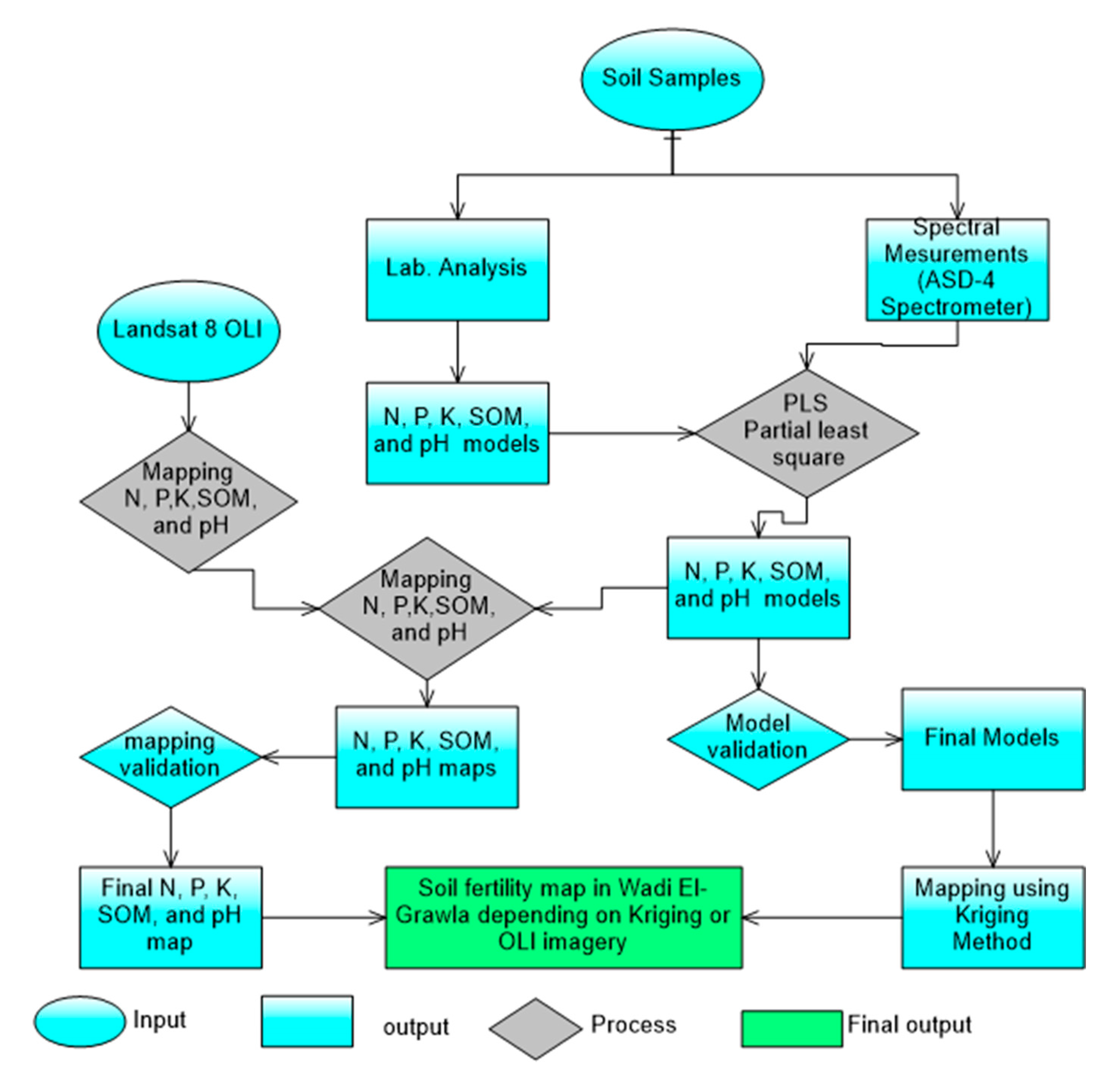
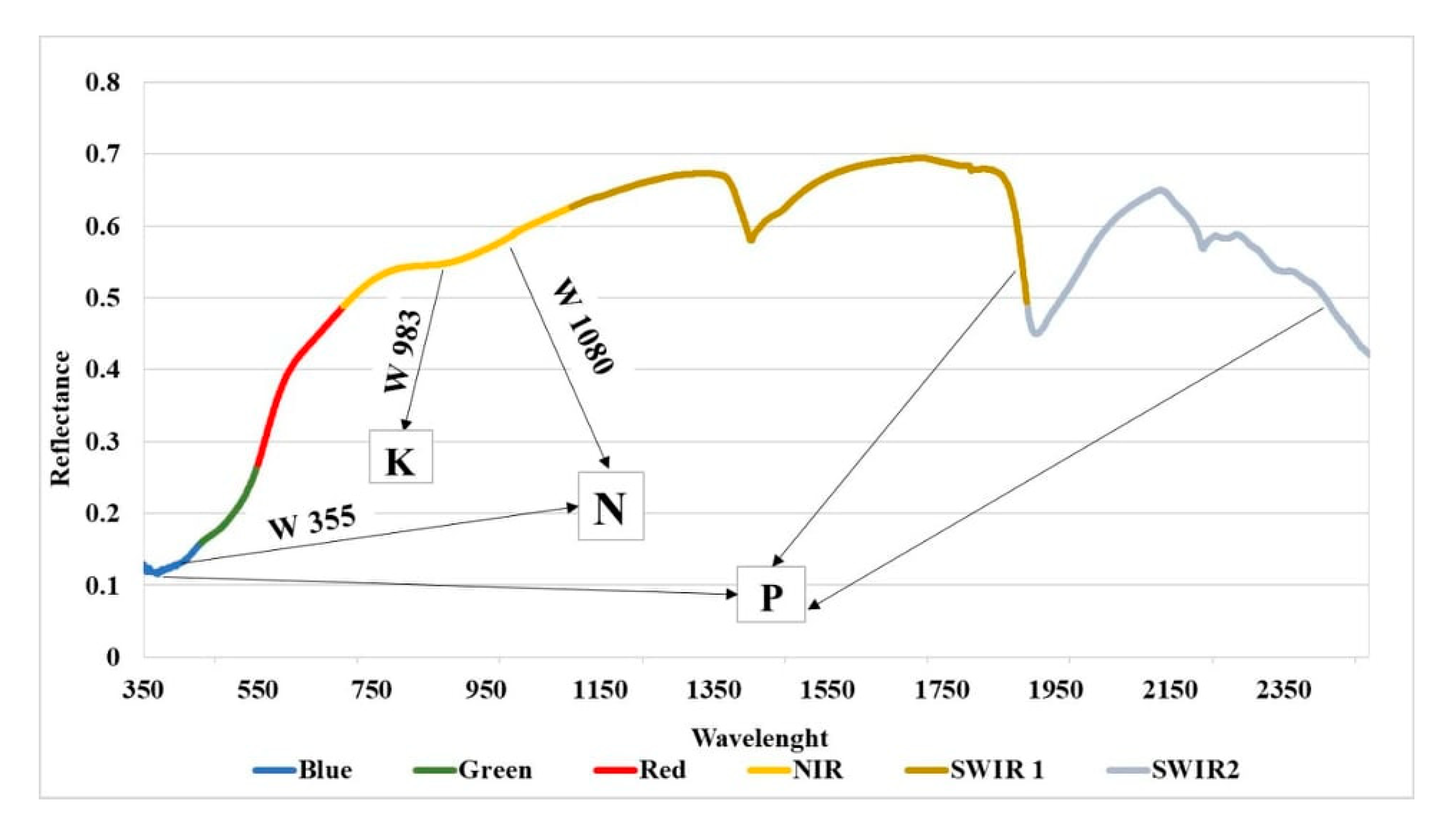
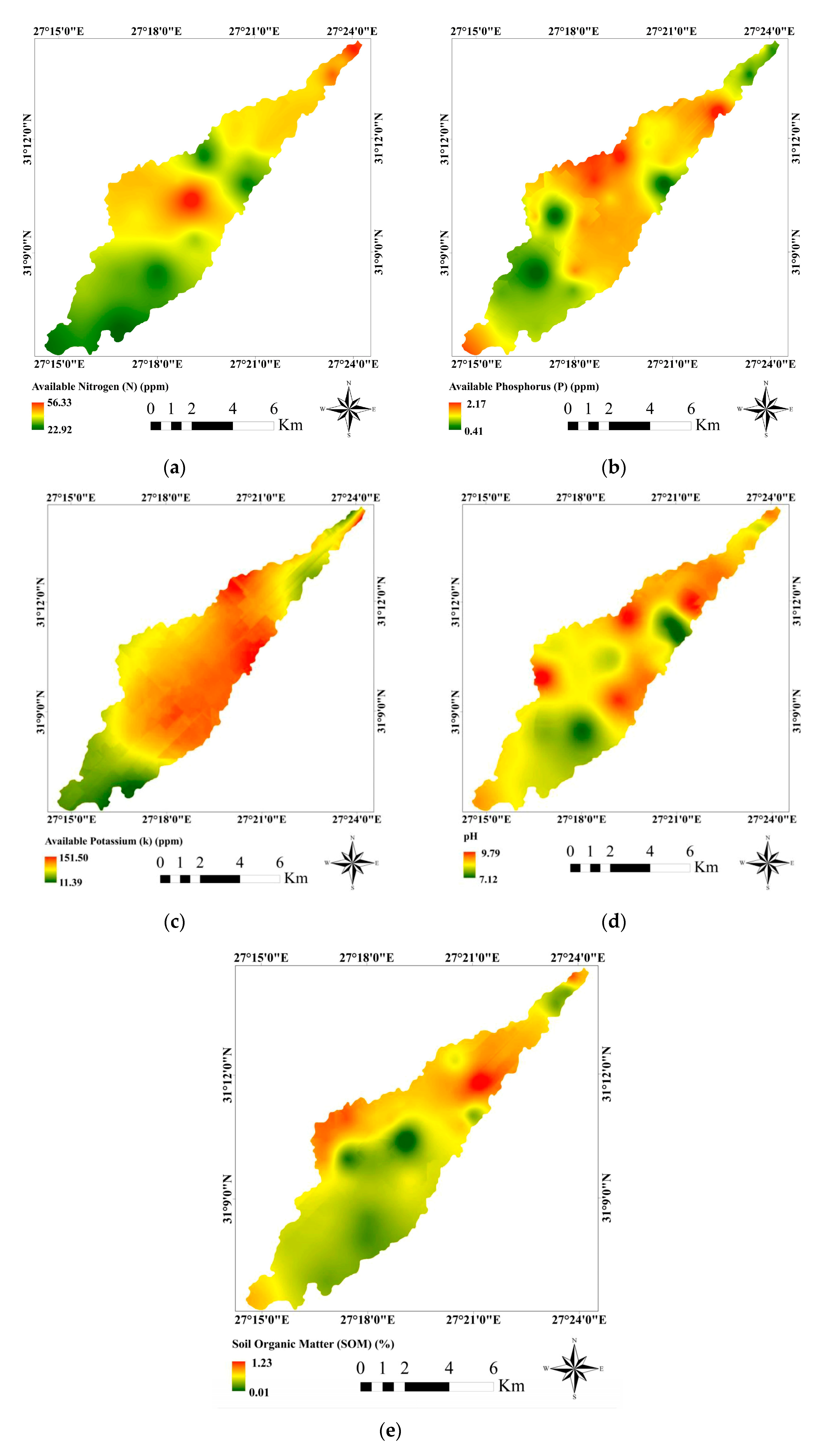
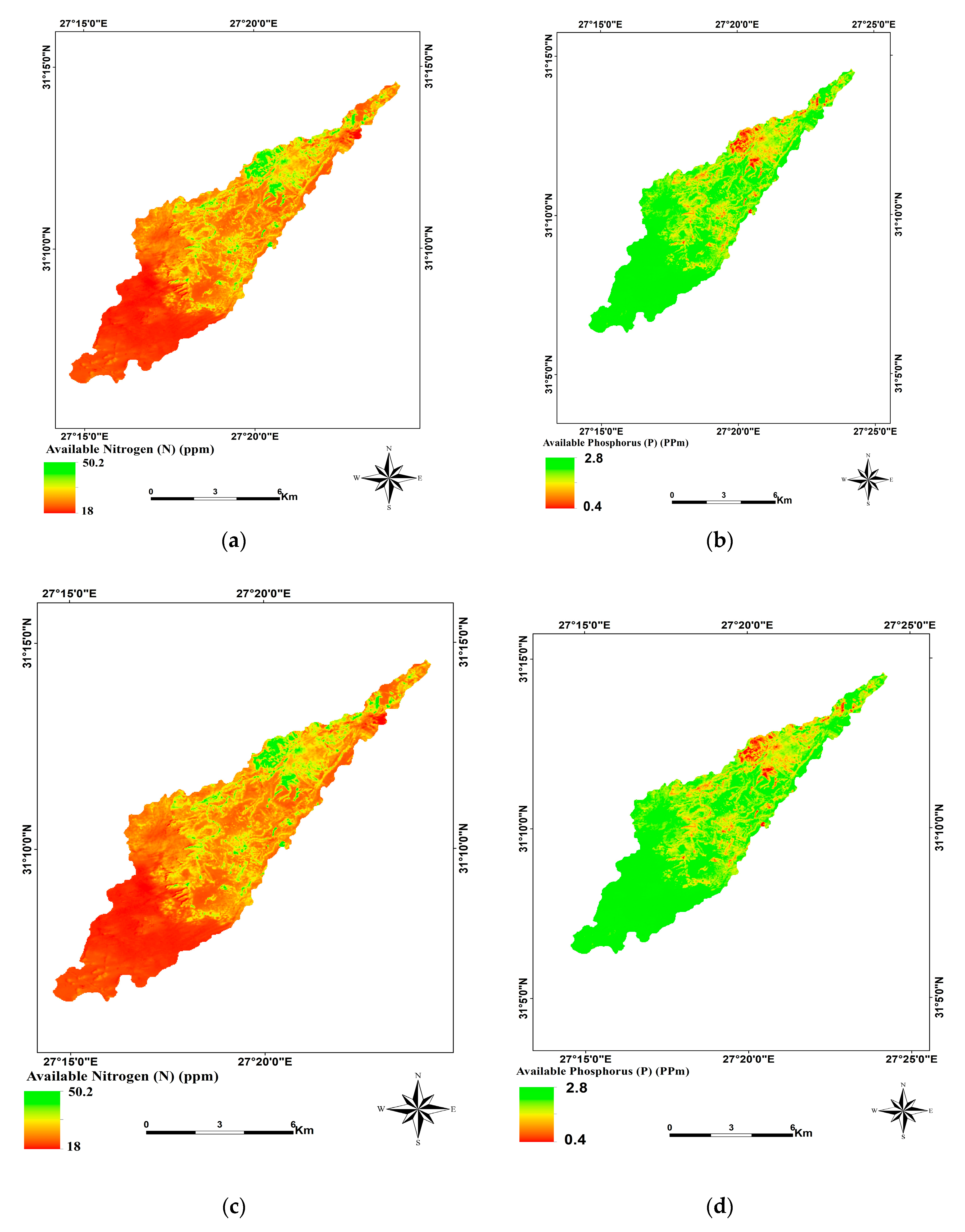


| Sand% | Silt% | Clay% | CaCO3% | pH | ECe (dS/m) | CEC (cmol/kg) | SOM% | |
|---|---|---|---|---|---|---|---|---|
| min | 92.14 | 0.02 | 2.27 | 2 | 6.56 | 0.11 | 0.86 | 0.04 |
| max | 96.85 | 2.91 | 6.26 | 37 | 8.97 | 10.53 | 5.66 | 1.57 |
| mean | 94.37 | 1.31 | 4.32 | 19.5 | 8.01 | 5.32 | 2.23 | 0.38 |
| Diagnostic Factor | Unit | 1 | 0.8 | 0.5 | 0.2 |
|---|---|---|---|---|---|
| N | mg/kg | >80 | 80–40 | 40–20 | <20 |
| P | mg/kg | >15 | 15–10 | 10–5 | <5 |
| K | mg/kg | >400 | 400–200 | 200–100 | <100 |
| SOM | g/100 g | >2 | 1–2 | 0.5–1 | <0.5 |
| pH | - | 5.5–7 | 7–7.8 | 7.9–8.5 | >8.5 |
| Ava. N ppm | Ava. P ppm | Ava. K ppm | pH | SOM% | |
|---|---|---|---|---|---|
| Min | 14.04 | 0.72 | 18 | 6.56 | 0.04 |
| Max | 60.41 | 2.43 | 152 | 8.97 | 1.57 |
| Mean | 37.23 | 1.58 | 85 | 8.01 | 0.38 |
| Standard deviation | 8.92 | 0.45 | 115.6 | 0.5 | 0.27 |
| Properties | R2 Calibration | Adj. R2 | RMSE | MR | NRMSE | NRMSE (%) | R2 Validation | Spectral Range |
|---|---|---|---|---|---|---|---|---|
| Ava. N | 0.89 | 0.86 | 0.11 | 1.01 | 0.01 | 1.29 | 0.87 | Blue–NIR |
| Ava. P | 0.72 | 0.7 | 0.24 | 1.12 | 0.69 | 68.57 | 0.87 | Blue–SWIR1–SWIR2 |
| Ava. K | 0.91 | 0.9 | 0.24 | 2.04 | 0.01 | 0.56 | 0.9 | NIR |
| pH | 0.65 | 0.61 | 0.19 | 8.02 | 0.27 | 26.76 | 0.69 | Blue–Green–SWIR2 |
| SOM | 0.75 | 0.73 | 0.12 | 0.41 | 0.44 | 44.44 | 0.84 | Blue–SWIR1–SWIR2 |
| Ava. N (ppm) | Ava. P (ppm) | Ava. K (ppm) | pH | SOM% | ||||||
|---|---|---|---|---|---|---|---|---|---|---|
| Measu. | Pred. | Measu. | Pred. | Measu. | Pred. | Measu. | Pred. | Measu. | Pred. | |
| Min | 14.04 | 22.92 | 0.72 | 0.44 | 18 | 11.39 | 6.56 | 7.12 | 0.04 | 0.01 |
| Max | 60.41 | 56.33 | 1.32 | 1.81 | 152 | 151.5 | 8.97 | 9.79 | 1.57 | 1.23 |
| Mean | 43.1 | 40.2 | 0.96 | 1.20 | 75.8 | 76.71 | 8.01 | 8.03 | 0.38 | 0.46 |
| Standard deviation | 9.3 | 8.5 | 0.16 | 0.35 | 41.7 | 43 | 0.7 | 0.71 | 0.27 | 0.27 |
| Soil Properties | Model Type | Mean | Root Mean Square (Rmse) | Mean Standardized (Mse) | Root-Mean-Square Standardized (Rmsse) | Average Standard Error |
|---|---|---|---|---|---|---|
| Ava. N | Spherical | 0.133 | 8.64 | 0.051 | 1 | 8.56 |
| Ava. P | Gaussian | −0.002 | 0.38 | −0.007 | 0.98 | 0.38 |
| Ava. K | Gaussian | 0.14 | 27.5 | 0.004 | 1.01 | 27.19 |
| pH | Spherical | 0.009 | 0.44 | 0.01 | 0.99 | 0.44 |
| SOM | Spherical | −0.005 | 0.22 | −0.019 | 0.97 | 0.23 |
| Properties | RMSE | NRMSE | R2 |
|---|---|---|---|
| Ava. N (ppm) | 3.5 | 0.39 | 0.71 |
| Ava. P (ppm) | 0.06 | 0.29 | 0.68 |
| Ava. K (ppm) | 4.3 | 0.076 | 0.55 |
| pH | 0.07 | 0.22 | 0.62 |
| Ava. SOM (%) | 0.02 | 0.18 | 0.7 |
Publisher’s Note: MDPI stays neutral with regard to jurisdictional claims in published maps and institutional affiliations. |
© 2020 by the authors. Licensee MDPI, Basel, Switzerland. This article is an open access article distributed under the terms and conditions of the Creative Commons Attribution (CC BY) license (http://creativecommons.org/licenses/by/4.0/).
Share and Cite
Mohamed, E.S.; Baroudy, A.A.E.; El-beshbeshy, T.; Emam, M.; Belal, A.A.; Elfadaly, A.; Aldosari, A.A.; Ali, A.M.; Lasaponara, R. Vis-NIR Spectroscopy and Satellite Landsat-8 OLI Data to Map Soil Nutrients in Arid Conditions: A Case Study of the Northwest Coast of Egypt. Remote Sens. 2020, 12, 3716. https://doi.org/10.3390/rs12223716
Mohamed ES, Baroudy AAE, El-beshbeshy T, Emam M, Belal AA, Elfadaly A, Aldosari AA, Ali AM, Lasaponara R. Vis-NIR Spectroscopy and Satellite Landsat-8 OLI Data to Map Soil Nutrients in Arid Conditions: A Case Study of the Northwest Coast of Egypt. Remote Sensing. 2020; 12(22):3716. https://doi.org/10.3390/rs12223716
Chicago/Turabian StyleMohamed, Elsayed Said, A. A El Baroudy, T. El-beshbeshy, M. Emam, A. A. Belal, Abdelaziz Elfadaly, Ali A. Aldosari, Abdelraouf. M. Ali, and Rosa Lasaponara. 2020. "Vis-NIR Spectroscopy and Satellite Landsat-8 OLI Data to Map Soil Nutrients in Arid Conditions: A Case Study of the Northwest Coast of Egypt" Remote Sensing 12, no. 22: 3716. https://doi.org/10.3390/rs12223716
APA StyleMohamed, E. S., Baroudy, A. A. E., El-beshbeshy, T., Emam, M., Belal, A. A., Elfadaly, A., Aldosari, A. A., Ali, A. M., & Lasaponara, R. (2020). Vis-NIR Spectroscopy and Satellite Landsat-8 OLI Data to Map Soil Nutrients in Arid Conditions: A Case Study of the Northwest Coast of Egypt. Remote Sensing, 12(22), 3716. https://doi.org/10.3390/rs12223716







